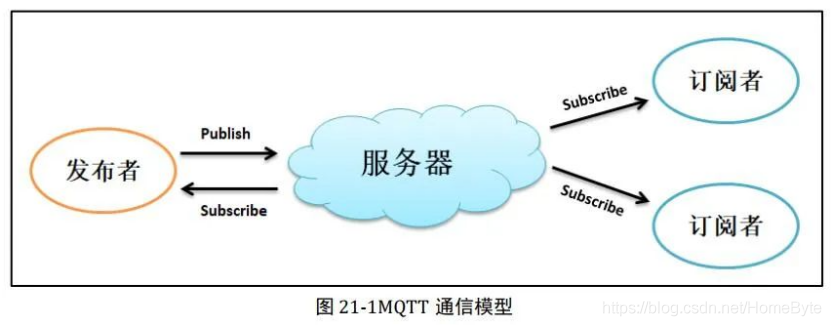mosquitto是一个第三方开源库,是一款实现了 MQTT v3.1 协议的开源消息代理软件,提供轻量级的,支持发布/订阅的的消息推送模式,使设备对设备之间的短消息通信简单易用。我们可以基于mosquitto非常简单的搭建MQTT服务器和客户端,并且能够很好的在嵌入式设备上进行应用。
mosquitto实现有如下几个特点:
poll()异步模型,竟然不是epoll,也许这注定了其只能支持十几万连接同时在线。
内存处理方面几乎没有任何优化,但简单可依赖;
多线程程序,许多地方都得加锁访问。但其实多线程的需求没那么强烈,可以考虑避免;
总之,是一个比较简单单可以适用于一般的服务中提供pub/sub功能支持,但如果放到大量并发的系统中,可以优化的地方还有很多。关于mosquitto的性能,暂时没有找到官方的评测,不过在 邮件组里面找到的一些讨论 似乎显示其性能上限为20W连接时在线的状态,当然具体取决于业务逻辑,交互是否很多等。不过这样的成绩还是不错的。
MQTT 基础概念
Broker(服务端, 代理者) ---- 使用PC(192.168.100.33:1883)机 运行mosquitto程序即可
Subscriber(客户端-订阅者) ---- 192.168.100.35 嵌入式板子A
Publisher(客户端-发布者) ---- 192.168.100.36 嵌入式板子B

方法一
获取mosquitto开源库同样可以通过github和官网两个方式,我们还是推荐通过官方网站来下载:https://mosquitto.org/
我们使用的版本是1.6.12
wget http://mosquitto.org/files/source/mosquitto-1.6.12.tar.gz
tar zxfv mosquitto-1.6.12.tar.gz
默认下载下来编译是X86,而且会有一些问题,我们需要修改Makefile,vim Makefile

这些地方都是没有什么用的,但是会导致编译问题,因此屏蔽掉!
然后我创建一个脚本文件make.sh:

内容很简单:

运行 ./make.sh就可以进行交叉编译了!
没有提示error表示编译成功:

编译后我们可以在lib目录下看到生成的库文件:

同样的,需要确定文件格式是否正确:

显示是ARM aarch64表示交叉编译输出成功
方法二
交叉编译 openssl-1.0.1c
tar -zxvf openssl-1.0.1c.tar.gz
cd openssl-1.0.1c
./config no-asm shared --prefix=/home/ares/mqtt/ssl-arm
// =====================================================
// 修改Makefile文件
CC = arm-none-linux-gnueabi-gcc
AR = arm-none-linux-gnueabi-ar $(ARFLAGS) r
RANLIB = arm-none-linux-gnueabi-ranlib
// =====================================================
make
make install交叉编译 mosquitto-1.4.14
tar -zxvf mosquitto-1.4.14.tar.gz
cd mosquitto-1.4.14
// =====================================================
// 修改config.mk文件
WITH_SRV:=no
WITH_UUID:=no
WITH_WEBSOCKETS:=no
WITH_DOCS:=no
CFLAGS += -I/home/ares/mqtt/ssl-arm/include
LDFLAGS += -L/home/ares/mqtt/ssl-arm/lib -lssl -lcrypto
STRIP?=arm-none-linux-gnueabi-strip
prefix=/home/ares/mqtt/mosquitto-arm
// =====================================================
make CC=arm-none-linux-gnueabi-gcc CXX=arm-none-linux-gnueabi-g++
make installMosquitto pub/sub服务实现代码浅析-主体框架
一、初始化
mosquitto.c文件main开头调用_mosquitto_net_init初始化SSL加密的库,然后调用mqtt3_config_init初始化配置的各个数据结构为默认值。配置文件的解析由mqtt3_config_parse_args牵头完成,具体配置文件解析就不多写了,fgets一行行的读取配置,然后设置到config全局变量中。其中包括对于监听地址等的读取。然后保存pid进程号。mqtt3_db_open打开db文件
int main(int argc, char *argv[])
{
memset(&int_db, 0, sizeof(struct mosquitto_db));
_mosquitto_net_init();
mqtt3_config_init(&config);
rc = mqtt3_config_parse_args(&config, argc, argv);//k: init && load config file, set struct members配置读取完后,就可以打开监听端口了,使用mqtt3_socket_listen打开监听端口,并将SOCK套接字放在局部变量listensock里面,以便后面统一使用。
listener_max = -1;
listensock_index = 0;
for(i=0; i<config.listener_count; i++){
if(mqtt3_socket_listen(&config.listeners[i])){
_mosquitto_free(int_db.contexts);
mqtt3_db_close(&int_db);
if(config.pid_file){
remove(config.pid_file);
}
return 1;
}
listensock_count += config.listeners[i].sock_count;
listensock = _mosquitto_realloc(listensock, sizeof(int)*listensock_count);
if(!listensock){
_mosquitto_free(int_db.contexts);
mqtt3_db_close(&int_db);
if(config.pid_file){
remove(config.pid_file);
}
return 1;
}
for(j=0; j<config.listeners[i].sock_count; j++){
if(config.listeners[i].socks[j] == INVALID_SOCKET){
_mosquitto_free(int_db.contexts);
mqtt3_db_close(&int_db);
if(config.pid_file){
remove(config.pid_file);
}
return 1;
}
listensock[listensock_index] = config.listeners[i].socks[j];
if(listensock[listensock_index] > listener_max){
listener_max = listensock[listensock_index];
}
listensock_index++;
}
}关于mqtt3_socket_listen函数也比较经典,socket(),bind(), listen()的流程,不同的是使用了新版的套接字信息获取函数getaddrinfo,该函数支持IPV4和IPV6,对应用层透明,不需要处理这些信息。
int mqtt3_socket_listen(struct _mqtt3_listener *listener)
{
snprintf(service, 10, "%d", listener->port);
memset(&hints, 0, sizeof(struct addrinfo));
hints.ai_family = PF_UNSPEC;
hints.ai_flags = AI_PASSIVE;
hints.ai_socktype = SOCK_STREAM;
//导致下面返回多个链表节的的因素可能有:
//hostname参数关联的地址有多个,那么每个返回一个节点;比如host为域名的时候,nslookup返回几个ip就有几个
//service参数指定的服务会吃多个套接字接口类型,那么也返回多个
if(getaddrinfo(listener->host, service, &hints, &ainfo)) return INVALID_SOCKET;
listener->sock_count = 0;
listener->socks = NULL;
for(rp = ainfo; rp; rp = rp->ai_next){
//····
sock = socket(rp->ai_family, rp->ai_socktype, rp->ai_protocol);
if(sock == -1){
strerror_r(errno, err, 256);
_mosquitto_log_printf(NULL, MOSQ_LOG_WARNING, "Warning: %s", err);
continue;
}
listener->sock_count++;
listener->socks = _mosquitto_realloc(listener->socks, sizeof(int)*listener->sock_count);
if(!listener->socks){
_mosquitto_log_printf(NULL, MOSQ_LOG_ERR, "Error: Out of memory.");
return MOSQ_ERR_NOMEM;
}
listener->socks[listener->sock_count-1] = sock;
/* Set non-blocking */
opt = fcntl(sock, F_GETFL, 0);
if(bind(sock, rp->ai_addr, rp->ai_addrlen) == -1){
strerror_r(errno, err, 256);
_mosquitto_log_printf(NULL, MOSQ_LOG_ERR, "Error: %s", err);
COMPAT_CLOSE(sock);
return 1;
}
if(listen(sock, 100) == -1){
strerror_r(errno, err, 256);
_mosquitto_log_printf(NULL, MOSQ_LOG_ERR, "Error: %s", err);
COMPAT_CLOSE(sock);
return 1;
}
}
freeaddrinfo(ainfo);
}二、消息事件循环
打开监听套接字后,就可以进入消息事件循环,标准网络服务程序的必须过程。这个由main函数调用mosquitto_main_loop启动。mosquitto_main_loop函数主体也是一个大循环,在循环里面进行超时检测,事件处理,网络读写等等。由于使用poll模型,所以就需要在进行poll()等待之前准备需要监听的套接字数组列表pollfds,效率低的地方就在这里。
对于监听套接字,简单将其加入pollfds里面,注册POLLIN可读事件即可。如果对于其他跟客户端等的连接,就需要多做一步操作了。如果是桥接模式,进行相应的处理,这里暂时不介绍桥接模式,桥接模式是为了分布式部署加入的非标准协议,目前只有IBM rsmb和mosquitto实现了。
对于跟客户端的连接,mosquitto会在poll等待之前调用mqtt3_db_message_write尝试发送一次未发送的数据给对方,避免不必要的等待可能。
int mosquitto_main_loop(struct mosquitto_db *db, int *listensock, int listensock_count, int listener_max)
{
memset(pollfds, -1, sizeof(struct pollfd)*pollfd_count);
pollfd_index = 0;
for(i=0; i<listensock_count; i++){//注册监听sock的pollfd可读事件。也就是新连接事件
pollfds[pollfd_index].fd = listensock[i];
pollfds[pollfd_index].events = POLLIN;
pollfds[pollfd_index].revents = 0;
pollfd_index++;
}
time_count = 0;
for(i=0; i<db->context_count; i++){//遍历每一个客户端连接,尝试将其加入poll数组中
if(db->contexts[i]){
//····
/* Local bridges never time out in this fashion. */
if(!(db->contexts[i]->keepalive)
|| db->contexts[i]->bridge
|| now - db->contexts[i]->last_msg_in < (time_t)(db->contexts[i]->keepalive)*3/2){
//在进入poll等待之前,先尝试将未发送的数据发送出去
if(mqtt3_db_message_write(db->contexts[i]) == MOSQ_ERR_SUCCESS){
pollfds[pollfd_index].fd = db->contexts[i]->sock;
pollfds[pollfd_index].events = POLLIN | POLLRDHUP;
pollfds[pollfd_index].revents = 0;
if(db->contexts[i]->current_out_packet){
pollfds[pollfd_index].events |= POLLOUT;
}
db->contexts[i]->pollfd_index = pollfd_index;
pollfd_index++;
}else{//尝试发送失败,连接出问题了
mqtt3_context_disconnect(db, db->contexts[i]);
}
}else{//超过1.5倍的时间,超时关闭连接
if(db->config->connection_messages == true){
_mosquitto_log_printf(NULL, MOSQ_LOG_NOTICE, "Client %s has exceeded timeout, disconnecting.", db->co
ntexts[i]->id);
}
/* Client has exceeded keepalive*1.5 */
mqtt3_context_disconnect(db, db->contexts[i]);//关闭连接,清空数据,后续还可以用.sock=INVALID_SOCKET
}
}else{
#endif
if(db->contexts[i]->clean_session == true){
//这个连接上次由于什么原因,挂了,设置了clean session,所以这里直接彻底清空其结构
mqtt3_context_cleanup(db, db->contexts[i], true);
db->contexts[i] = NULL;
}else if(db->config->persistent_client_expiration > 0){
//协议规定persistent_client的状态必须永久保存,这里避免连接永远无法删除,增加这个超时选项。
//也就是如果一个客户端断开连接一段时间了,那么我们会主动干掉他
/* This is a persistent client, check to see if the
* last time it connected was longer than
* persistent_client_expiration seconds ago. If so,
* expire it and clean up.
*/
if(now > db->contexts[i]->disconnect_t+db->config->persistent_client_expiration){
_mosquitto_log_printf(NULL, MOSQ_LOG_NOTICE, "Expiring persistent client %s due to timeout.", db-
>contexts[i]->id);
#ifdef WITH_SYS_TREE
g_clients_expired++;
#endif
db->contexts[i]->clean_session = true;
mqtt3_context_cleanup(db, db->contexts[i], true);
db->contexts[i] = NULL;
}
}
#ifdef WITH_BRIDGE
}然后先使用mqtt3_db_message_timeout_check检测一下超时没有收到客户端回包确认的消息,mosquitto对于超时的消息处理,是会进行重发的。不过理论上,TCP是不需要重发的,具体见这里: MQTT消息推送协议应用数据包超时是否需要重发? 不过,由于mosquitto对于客户端断开连接的处理比较弱,连接重新建立后,使用的相关数据结构还是相同的,因此重发其实也可以,只是这个时候的重发,实际上是在一个连接上没有收到ACK回包,然后后续建立的新连接上进行重传。不是在一个连接上重传。但是这样其实也有很多弊端,比如客户端必须支持消息的持久化记录,否则容易双方对不上话的情况。
int mqtt3_db_message_timeout_check(struct mosquitto_db *db, unsigned int timeout)
{//循环遍历每一个连接的每个消息msg,看起是否超时,如果超时,将消息状态改为上一个状态,从而后续触发重发
int i;
time_t threshold;
enum mosquitto_msg_state new_state = mosq_ms_invalid;
struct mosquitto *context;
struct mosquitto_client_msg *msg;
threshold = mosquitto_time() - timeout;
for(i=0; i<db->context_count; i++){//遍历每一个连接,
context = db->contexts[i];
if(!context) continue;
msg = context->msgs;
while(msg){//遍历每个msg消息,看看其状态,如果超时了,那么从上一个消息开始重发.其实不需要重发http://chenzhenianqing.cn/ar
ticles/977.html
//当然如果这个是复用了之前断开过的连接,那就需要重发。但是,这个时候其实可以重发整个消息的。不然容易出问题,客户端难>
度大
if(msg->timestamp < threshold && msg->state != mosq_ms_queued){
switch(msg->state){
case mosq_ms_wait_for_puback:
new_state = mosq_ms_publish_qos1;
break;
case mosq_ms_wait_for_pubrec:
new_state = mosq_ms_publish_qos2;
break;
case mosq_ms_wait_for_pubrel:
new_state = mosq_ms_send_pubrec;
break;
case mosq_ms_wait_for_pubcomp:
new_state = mosq_ms_resend_pubrel;
break;
default:
break;
}
if(new_state != mosq_ms_invalid){
msg->timestamp = mosquitto_time();//设置当前时间,下次依据来判断超时超时提前检测完成后就可以进入poll等待了。等待完成后,对于有可读事件的连接,调用loop_handle_reads_writes进行事件读写处理,对于监听端口的事件,使用mqtt3_socket_accept去接受新连接。
loop_handle_reads_writes新事件处理函数比较简单,主体还是循环判断可读可写事件,进行相应的处理。具体不多介绍了,需要关注的是由于是异步读写,所以需要记录上次读写状态,以便下次进入上下午继续读取数据。可写事件由_mosquitto_packet_write完成,可读事件由_mosquitto_packet_read完成。
新客户端连接的事件则由qtt3_socket_accept完成,其会将新连接放在db->contexts[i]数组的某个空位置,每次都会遍历寻找一个空的槽位放新连接。这里有个小优化其实就是用hints的机制,记录上次的查找位置,避免多次重复的从前面找到后面。
连接读写事件处理完成后,mosquitto会检测是否需要重新reload部分配置文件。这个由SIGHUP的信号触发。
三、总结
mosquitto是一个简单可依赖的开源MQTT实现,能支持10W左右的同时在线(未亲测),单机版本,但通过bridge桥接模式支持部分分布式,但有限;协议本身非常适合在移动设备上使用,耗电少,处理快,属于header上带有消息体长度的协议,这个在异步网络事件代码编写时是码农最爱的。
对于后续的提高优化的地方,简单记录几点:
发送数据用writev
poll -> epoll ,用以支持更高的冰法;
改为单线程版本,降低锁开销,目前锁开销还是非常大的。目测可以改为单进程版本,类似redis,精心维护的话应该能达到不错的效果;
网络数据读写使用一次尽量多读的方式,避免多次进入系统调用;
内存操作优化。不free,留着下次用;
考虑使用spwan-fcgi的形式或者内置一次启动多个实例监听同一个端口。这样能更好的发挥机器性能,达到更高的性能;